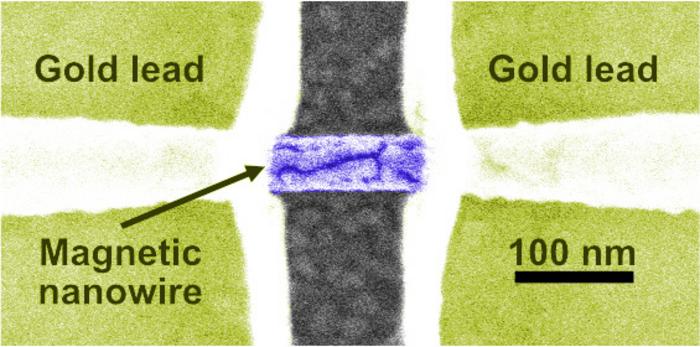
In a groundbreaking study published in Nature Nanotechnology, researchers from the University of Utah and the University of California, Irvine (UCI) have unveiled the first-ever spintronic prototype device that harnesses the anomalous Hall torque effect. This breakthrough marks a significant leap in the field of spintronics, a domain that merges magnetism with electronic charge to create faster and more energy-efficient computing applications. The research responds to the urgent demands of our data-driven society, which increasingly necessitates rapid advancements in computational capabilities.
At the heart of traditional electronics lies the manipulation of electron charge for information processing. However, the emerging field of spintronics diverges from this paradigm by leveraging both the charge and the intrinsic spin of electrons. By encoding binary values into spin orientations—assigning ‘up’ to 0 and ‘down’ to 1—spintronic devices provide a formidable alternative, enabling unprecedented speeds and efficiency. This innovative approach allows for a robust platform that can potentially revolutionize data storage and processing technologies.
A cornerstone of effective spintronic technology is the mastery of quantum properties inherent in materials. One such property, termed spin-torque, plays a vital role in the manipulation of magnetization through electrical currents. The recent research led by Eric Montoya, an assistant professor of physics and astronomy at the University of Utah, sheds light on a new variant of spin-torque known as anomalous Hall torque. Published on January 15, 2025, this pivotal study outlines how this newly discovered torque allows for the precise control of spin and magnetization, opening avenues for novel applications previously deemed impractical.
Montoya elucidates the significance of this discovery as both a fascinating scientific phenomenon and a potential catalyst for transformative applications. He emphasizes that these self-generated spin-torques are particularly well-suited for emerging computing paradigms such as neuromorphic computing. This innovative approach aims to replicate the operational principles of human brain networks, thereby enhancing the efficacy of computational systems.
To grasp the implications of anomalous Hall torque, one must first appreciate the intricate behavior of electrons. Each electron possesses an inherent magnetic field due to its spin, resembling miniature magnets with observable orientations. This study delves into the dynamics of spin-orientation torque, wherein electricity segregates electrons based on their spin, a distribution critically impacting the properties of materials, including the flow of magnetic fields within ferromagnets.
The anomalous Hall effect, first identified by Edwin Hall in 1881, serves as the foundation for understanding anomalous Hall torque. The effect arises when electrons traverse magnetic materials, leading to an asymmetric scattering that results in a charge current deviating 90 degrees from the applied electric current. This study reveals a parallel occurrence in terms of spin: when electrical currents are injected into specific materials, a spin current also flows perpendicularly, enriching our understanding of spin dynamics.
Montoya elaborates on the implications of symmetry in various Hall effects, which dictate the efficiency with which spin-orientation can be controlled. The interplay between these phenomena gives material scientists a unique capability to engineer devices with tailored functionalities. By manipulating Hall effects, the study introduces a framework for exploring how different materials can exhibit distinct spin-torque effects.
The research introduces the concept of self-generated spin-orbit torques, with the anomalous Hall torque emerging as a significant player. Alongside spin Hall torque and planar Hall torque, identified in previous studies, these phenomena coalesce to form a triad of Hall-like spin-orbit torques. Termed “Universal Hall torques,” this triad offers researchers a powerful toolkit for advancing spintronic device design and optimization.
Unlike traditional spintronic configurations, which often involve a non-magnetic layer flanked by two ferromagnetic layers, the research elucidates a groundbreaking approach. The team demonstrated that in their prototype device, spin-orientation can be seamlessly transferred from a ferromagnetic conductor to an adjacent non-magnetic material. This innovation eliminates the necessity for a second ferromagnetic layer, thereby simplifying device architecture while enhancing performance.
Krivorotov, a co-author and physicist at UCI, highlights the implications of their prototype—an unprecedented spin-torque oscillator that mimics neuronal behavior. By achieving this at a nanoscale, the device operates at unparalleled speeds, paving the way for interconnecting multiple such devices into larger networks. This interconnectedness could enable neuromorphic tasks such as image recognition, effectively merging computational efficiency with intelligent processing.
This research represents a testament to the ongoing evolution in the realm of spintronics, where each discovery builds upon the last in a relentless pursuit for faster and more efficient computing solutions. The unraveling of anomalous Hall torque ignites excitement within the scientific community, as it not only enriches the fundamental understanding of material behaviors but also promises practical applications in fields such as data storage, processing, and artificial intelligence.
As researchers continue to explore the properties and potential of these emerging materials and torques, the next steps involve scaling up the technology and refining the devices for practical deployments. Innovative collaborations and funding from organizations such as the National Science Foundation underscore the commitment to driving this field forward and unlocking the boundless possibilities that lie ahead in the intersection of spintronics and electronics.
The future of spintronics is bright, with each advancement revealing new dimensions of possibilities. As research continues to unfold, the potential for applications in next-generation computing becomes ever more tantalizing, driving scientists and engineers to push the boundaries of what is achievable in this dynamic frontier.
Subject of Research:
Article Title: Anomalous Hall spin current drives self-generated spin-orbit torque in a ferromagnet
News Publication Date: 15-Jan-2025
Web References:
References:
Image Credits: Adapted from Montoya et. al., (2025) Nature Nanotech
Keywords
Spintronics, anomalous Hall torque, neuromorphic computing, quantum properties, magnetic materials, data storage, spin dynamics, materials science.





